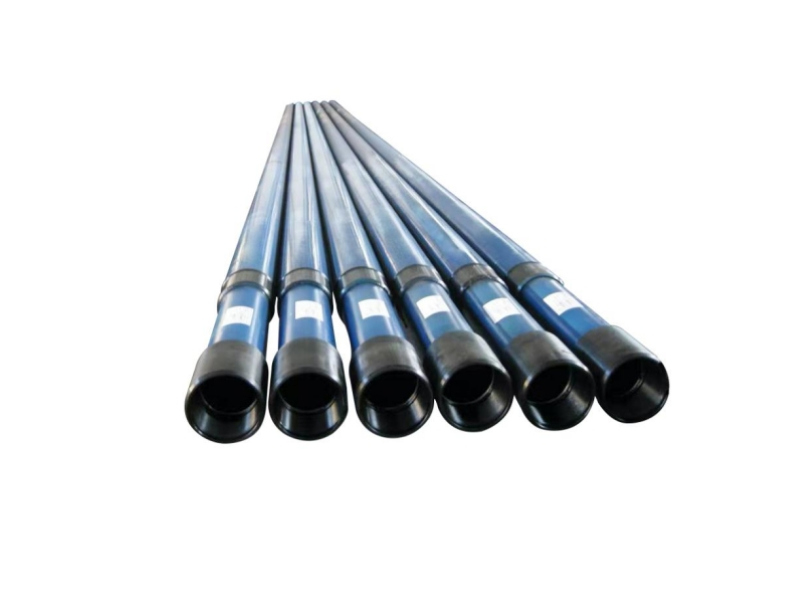Due to the continuous development of industry and economy, the exploitation of oil wells has continued to increase, and the demand for sucker rod pumps has also continued to increase.
Sucker rod pump is the main equipment in the rod pumping system. Depending on the depth of the oil well, production capacity, and crude oil properties, the required type of sucker rod pump structure will also be different.
Sucker rod pump is mainly composed of working cylinder, piston, play valve and fixed valve.
Working cylinder:
The working cylinder can be said to be the main body of the sucker rod pump. It is mainly composed of outer tube, bushing and coupling. The outer tube can also be called a pump barrel. The outer tube is equipped with a bushing of multiple concentric cylindrical tubes. The upper and lower ends are tightened by the clamping coupling. The upper coupling is connected to the oil pipe, and the lower coupling is connected to the fixed valve and the oil inlet equipment.
Piston:
The piston is generally called a plunger. In terms of material, it is a hollow cylinder made of seamless steel pipe. At the same time, there are internal threads at both ends, which are used to connect the travel valve or other parts.
There are chamfers at both ends of the plunger, which will make assembly much easier.
Floating valve:
Floating valve is also generally called discharge valve, and is usually called floating valve in oil field. It is composed of valve ball, valve seat and valve cover. Double valve pump has only one floating valve installed on the upper end of piston; three valve pump has two floating valves, installed on the upper and lower ends of piston respectively.
Fixed valve:
Fixed valve is also called suction valve. In addition to valve ball, valve seat and valve cover, it also has a fishing head for fishing out during oil well operation or facilitating other operations.

Sucker rod pump can be divided into tube pump and rod pump according to its structure:
(1) Tube pump:
Tube pump is to assemble the outer tube and bushing on the ground, connect them to the lower part of the oil pipe and lower them into the well, then put in the fixed valve, and finally connect the piston to the lower end of the sucker rod column and lower it into the pump barrel. Its characteristics are: simple structure, convenient processing, low price, and the pump diameter allowed to be lowered is larger than that of the rod pump under the same tubing diameter, so the displacement is larger. However, the tubing needs to be pulled out when inspecting and replacing the pump, and the workload of well repair is large. It is suitable for oil wells with high production and shallow depth.
Tube pumps can be divided into double-valve and three-valve tubular pumps according to the number of valves.
(2) Rod pump:
The rod pump is a piston, valve and working cylinder assembled into a whole. After being assembled on the ground, it is connected to the lower end of the sucker rod column and lowered into the well through the tubing. It is fixed to the tubing by the retaining ring pre-installed at the predetermined position of the tubing. Its advantage is that the pump is easy to inspect, and the tubing does not need to be pulled out. The pump can be taken out by taking out the sucker rod; its disadvantage is that the pump structure is complex, the processing is difficult, and the cost is high. The pump diameter allowed to be lowered under the same tubing diameter is smaller than that of the tube pump, so the displacement is smaller. Therefore, the rod pump is suitable for wells with large pumping depth and low production.
Basic parameters of Sucker rod pump:
25-175TH7.2-1.2-1.2
25-150RHAM7.2-1.2-1.2
First 2 digits: oil pipe code;
Last 3 digits: Sucker rod pump diameter code;
Pump type:
Letter T: Tube pump code;
Letter R: Rod pump code;
Pump barrel type:
Letter H: Thick-walled pump barrel (for metal plunger);
Letter W: Thin-walled pump barrel (for metal plunger);
Letter S: Thin-walled pump barrel (for soft-seal plunger);
Letter P: Thick-walled pump barrel (for soft-seal plunger);
Support assembly position:
Letter A: Top;
Letter B: Bottom;
Letter T: Bottom, moving barrel type;
Support assembly type:
Letter C: Leather cup type;
Letter M: Mechanical type;
The numbers after the letters are: Pump barrel length, plunger length, and total length of extended coupling/short section.
Note: China commonly uses tubular pumps with fixed valves connected to the pump barrel. There is no support code in the code, and generally no need to lengthen the short section.
Pump constant = theoretical daily output when the stroke is 1 meter and the number of strokes per minute is 1.
Pump theoretical daily output = pump constant * stroke * number of strokes.
Sucker rod pump maximum outer diameter:
Tube pump refers to the diameter of the pump barrel coupling, rod pump refers to the largest diameter in the pump barrel assembly (the top mechanical support rod pump is the ferrule diameter, the bottom mechanical support rod pump is the valve stem guide sleeve diameter, and the leather cup support refers to the leather cup diameter.
The basic information about sucker rod pumps is temporarily sorted here. Sucker rod pumps are an indispensable key equipment for oil field work. Next time, we can sort out more detailed information for you.

